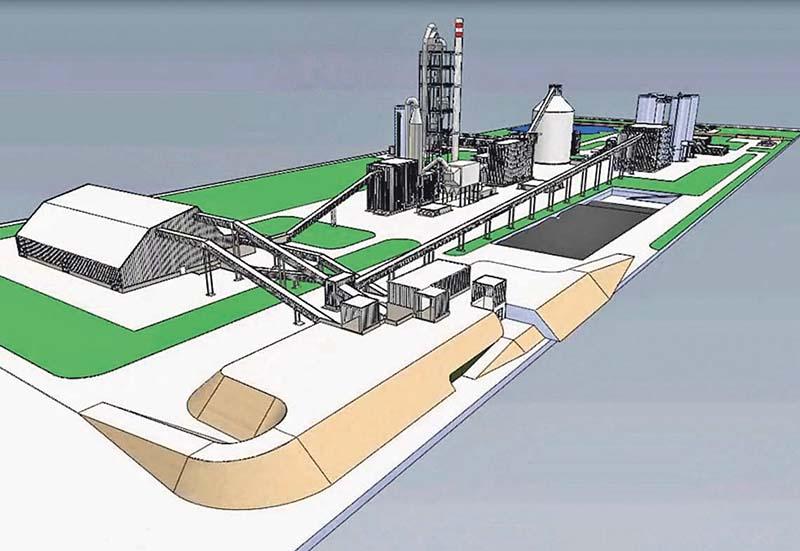The Ontario Local Planning Appeal Tribunal (LPAT) hearing into decisions made by United Counties of Prescott and Russell (UCPR) and Champlain Township council involving a proposed Colacem cement plant near L’Orignal began on Monday, November 9.
Due to the pandemic, the hearing is being held entirely online with the opportunity for the public to view and listen to the proceedings.
Colacem Canada, which is now owned by Béton Provincial, appealed a 2017 decision by Champlain Township council denying it the Zoning By-law Amendment (ZBA) needed to build the plant. Action Champlain, a group of residents and environmentalists, is appealing a June 14, 2017 decision by UCPR council to approve the Official Plan Amendment (OPA) that was required to construct the plant.
UCPR Director of Planning and Forestry Louis Prévost explained that the quarry property is 39.9 hectares or 99 acres and the OPA involved changing the site from an Industrial Policy Area to an Industrial Heavy Special Acceptance Zone as per the Planning Act. The maximum building height on the site is 125 metres and there are approximately 20 homes and farm buildings within a one-kilometre radius.
Prévost identified the reports on archeology, traffic safety, environmental impact, groundwater, air pollution, and noise emissions that have been performed regarding the potential plant since 2016. He said that all studies were peer-reviewed by other firms, county staff, and the South Nation Conservation Authority. He said that based on the studies and the review process, UCPR council was satisfied and adopted the OPA.
“These tests have clearly been met,” said Chris Barnett, legal counsel for Colacem.
He added that Champlain council’s rejection of the ZBA was based only on public opposition but that decisions should only be made based on evidence.
Colacem project manager Marc Bataille explained that cement is the main ingredient in concrete and that limestone from the quarry will be used as the main ingredient in the cement manufactured there. The product made from crushing and heating the ingredients is called clinker, and Bataille estimated that three million tonnes per year would be produced in L’Orignal. The kiln at the plant will be fuelled with petroleum coke-or pet coke, which is made from the oil refining process.
The company estimates that the cement plant will create 200 jobs over a three-year development period and 125 full-time jobs once the facility is operational. The estimated cost of building the plant is $225 million.
Colacem plans to use water from the quarry to cool the kiln at the cement plant. Bataille said that the existing permit to take water from the quarry allows the company to increase its depth by 10 metres so that it can have a an 80-day supply of water for cooling.
Gabriel Poliquin, counsel for Action Champlain, questioned Bataille extensively about if he had data explaining the potential for bag filters and dust collection systems to control emissions from the plant.
“We do not have that information,” said Bataille.
Colacem legal counsel Chris Barnett noted that those details should be left for experts to answer and said that Bataille had answered the best he could. Those details could be provided by Giuseppe Tomaselli and Sean Capstick of Golder Associates, the firm hired by Colacem to study noise and environmental issues related to the plant.
Five to 14 trucks per hour could be entering and leaving the cement plant by way of Highway 17. Bataille acknowledged to Poliquin that there would be increased traffic at night due to trucks delivering pet coke which will be arriving by ship in Montréal. Unlike some aspects of plant operations, the kiln would not be operating 24 hours a day.
The addition of the cement plant would increase limestone extraction activities in the quarry by five times from the current output. Bataille suspected that the quarry would generate a similar amount of dust to what it already creates. The limestone from the quarry will be taken directly to crushers at the plant to begin the production process.
Ronald Caza, a lawyer also representing Action Champlain requested that Bataille be prevented from discussing evidence with other witnesses who will be appearing before the hearing.
“It’s ridiculous,” was UCPR counsel Greg Meeds’ response.
“They have no need to hear the evidence of Mr. Bataille,” said Caza, who said such requests are common in hearings.
“Having practiced before the tribunal for 20 years, I’ve never seen it once,” said Meeds.
Robinson asked for email submissions from each party in favour or against Caza’s request and said that a decision would be made before the hearing reconvened on Tuesday morning.
The LPAT hearing into the cement plant continues on weekdays until November 25, except for November 11. Proceedings begin at 10 a.m. each day and can be viewed on zoom at https://zoom.us/j/97505929893?pwd=TlhjTjVBZ1ZyWmE4TkxjZlZwY1lTZz09. The meeting ID Zoom viewers must enter to access the hearing is 975 0592 9893, and the passcode they also must enter is 856658. The hearing can also be followed on Youtube at https://www.youtube.com/channel/UCxDAcq6BD8wgOUfSV-yGVRA/videos, or by phone, toll-free at 1-647-374-4685 from within Canada, and 1-888-475-4499 toll-free in the United States.


